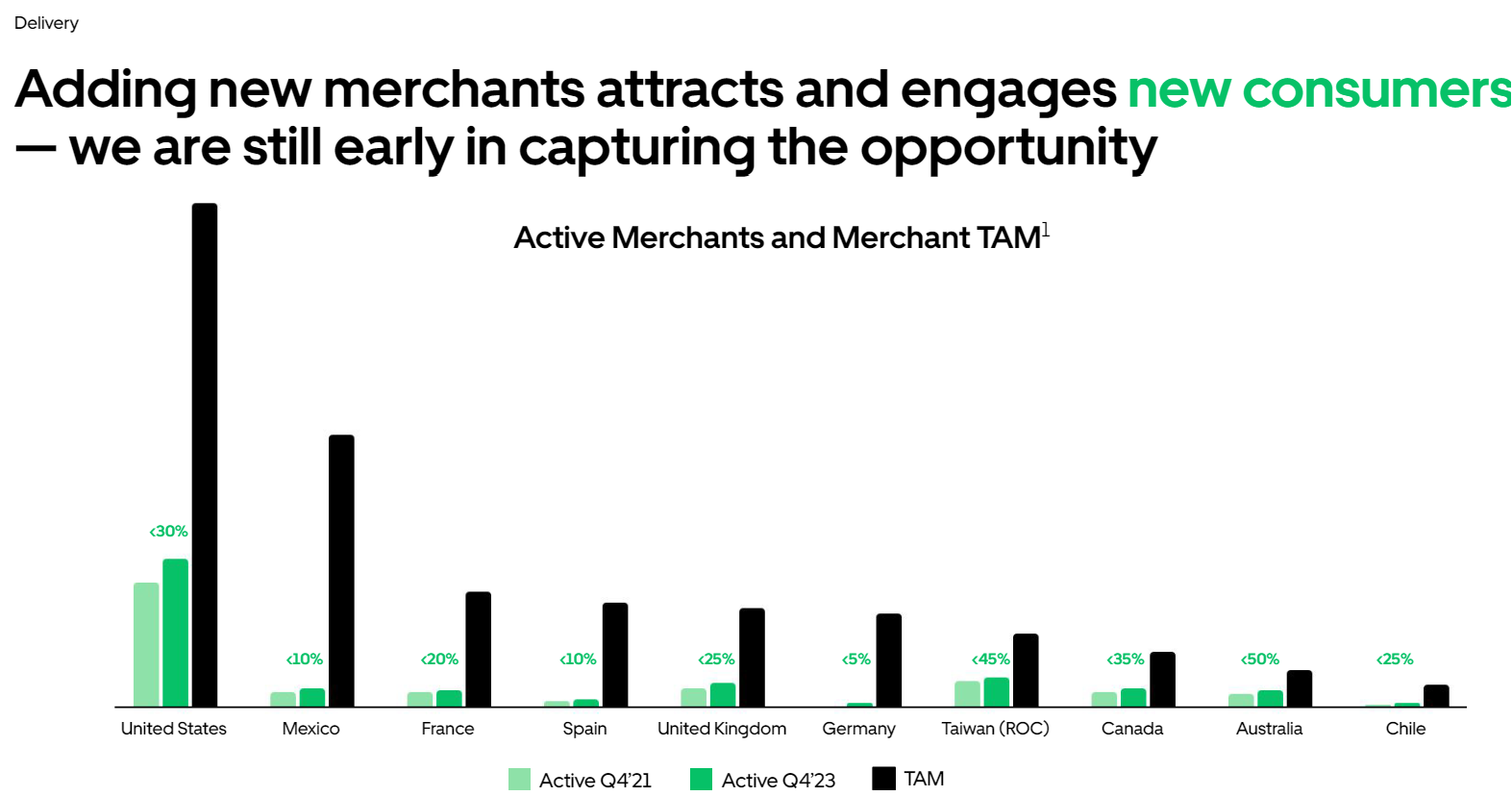

登錄


登錄
海擇短評 Haize Comment:
Uber(NYSE: UBER)面對了GAAP轉盈後的首次挑戰,亦即,月活躍支付用戶(Monthly Active Platform Consumers, MAPCs)出現轉盈後的首次下滑,以及滴滴(OTCMKTS: DIDIY)成為拉丁美洲市場的競爭對手,目前我們還不確定這兩個挑戰未來是不是同一個挑戰。通過2024Q1財報,投資人可能會想知道的是,Uber距離增長的極限還有多遠?面對滴滴的拉丁美洲之戰,會對未來財務造成什麼影響?海擇資本根據Q1財報解讀如下:
1. 淨利創新高、無衰竭之象:本季Uber的月活躍支付用戶雖然出現轉盈的首次下滑,幅度約1%,但從其他財務/運營指標來看,大體仍在穩定上升,如:交易額376.5億美元、收入101.3億美元 、Adjusted EBITDA 13.8億美元,三項指標都再創歷史新高成長。Q2預期的收入增速也保持在20%以上,目前甚至都還看不到季節性因素對Uber收入造成的衝擊。
2. 增長的頭部極限尚遠:一般在衡量預訂平台常用的指標之一是"支付用戶數 X 消費頻次 X 消費單價"。從這個角度來看,目前Uber雖然支付用戶數見頂,但其在不同的消費場景間、不同的國家間,還有很多可以提高消費頻次與消費單價的產品可供拓展;本次電話會議公司也提到了,針對商務場景的U4B、健康服務場景的Reserve、低客單價場景的UberX Share(可以理解為順風車),YoY增速都在80%以上,差別在於Uber如何安排在各國推出的優先級與行銷規模。此外,Uber的會員費"Uber One"的季度收入已超過10億美元,目前會員產生消費佔總交易額的32%,佔配送交易額的45%,會員的月支出是非會員的3.4倍,從這些點看,海擇資本認為Uber的多產品線至少是被用戶認同的。
3. 拉丁美洲硝煙味濃:Uber管理層在電話會議也正面回應了與滴滴在拉丁美洲市場的競爭。海擇資本認為,拉丁美洲對Uber是重要且高貢獻的市場,光阿根廷比索匯率的跌價,就對網約車事業的年增率造成5%的影響,其規模可見一斑。至於與滴滴的競爭,公司自認為在財務效率、網絡效率等方面比滴滴高效,並認為滴滴無資本紀律的行銷投放,將只是暫時(但幾乎每家公司面對競爭都會這麼說對手)。真正值得關注的是,公司認為能創造高投資回報的市場很多,會將資金轉移到ROI更高的業務目標,因此Q2的盈利能力還會上升。基於這樣的論點,海擇資本論斷,在滴滴對拉丁美洲市場的控制能力夠大之前,Uber不會快速與滴滴進入深度的價格戰;反之,一旦我們觀察到Uber在拉美市場與滴滴的搏殺快速趨於激烈之時,就可斷定Uber在各國的增量已不足以彌補在拉美市場的損失。
-------
Uber (NYSE: UBER) faced its first challenges after achieving GAAP profitability: a decline in Monthly Active Platform Consumers (MAPCs) for the first time since turning profitable, and Didi (OTCMKTS: DIDIY) emerging as a competitor in the Latin American market. It is still uncertain whether these two challenges will merge into a single issue. From the Q1 2024 financial report, investors might wonder how far Uber is from its growth limits and what impact Didi's competition in Latin America could have on its future finances. Haize Capital provides the following analysis based on the Q1 financial report:
1. Record profits, no signs of decline: This quarter, although Uber's Monthly Active Platform Consumers (MAPCs) saw their first decline since turning profitable, by about 1%, other financial and operational metrics generally continue to rise. For instance, the gross bookings reached $37.65 billion, revenue hit $10.13 billion, and Adjusted EBITDA stood at $1.38 billion—all marking new historical highs. Q2's revenue growth is also expected to maintain over 20%, with no apparent seasonal impacts on Uber's revenue yet visible.
2. Room for growth remains vast: A common metric for booking platforms is "number of paying users X frequency of transactions X average transaction value." From this perspective, although Uber's number of paying users has peaked, there is significant potential to increase transaction frequency and value across various consumption scenarios and countries. In the latest earnings call, the company highlighted products like Uber for Business (U4B), health service scenario Reserve, and low-cost option UberX Share, all with YoY growth rates above 80%. The challenge for Uber lies in prioritizing and scaling these offerings in different countries. Additionally, revenue from Uber’s membership fee "Uber One" has surpassed $1 billion per quarter, with members accounting for 32% of total gross bookings and 45% of delivery transactions. Members spend 3.4 times more monthly than non-members, indicating strong user recognition of Uber’s diversified product lines, as per Haize Capital.
3. Intense competition in Latin America: During the earnings call, Uber's management addressed the competition with Didi in the Latin American market. Haize Capital notes that Latin America is a significant and high-contributing market for Uber. The depreciation of the Argentine peso alone has a 5% impact on the annual growth rate of the ride-hailing business, indicating its scale. Regarding competition with Didi, Uber believes it has better financial and network efficiencies and views Didi’s capital-indisciplined marketing expenditures as temporary (a common claim against competitors). More importantly, the company suggests there are many markets capable of generating high returns on investment and plans to redirect funds towards higher ROI business objectives, which should enhance Q2 profitability. Based on this argument, Haize Capital predicts that Uber will not quickly engage in a deep price war with Didi in Latin America unless Didi gains significant control. Conversely, should the competition between Uber and Didi in Latin America intensify quickly, it would indicate that Uber’s growth in other countries is insufficient to offset losses in Latin America.


標籤 Label: UBER DIDIY Latin America Ride-hailing Food-delivery